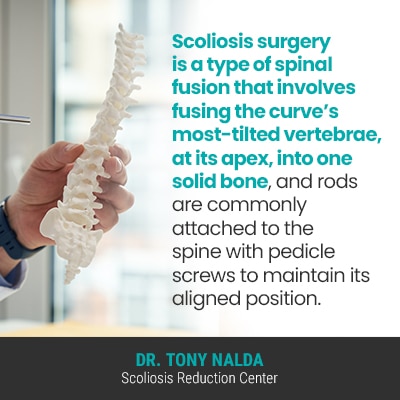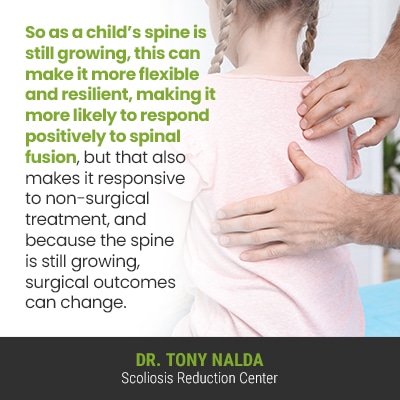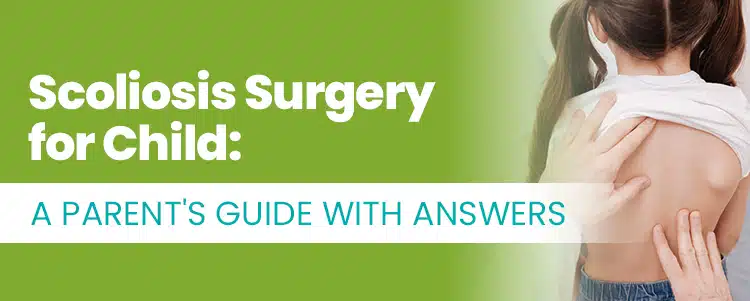When a child is diagnosed with scoliosis, naturally, parents have a lot of questions and concerns, one of which is how best to treat the condition moving forward. There are a lot of factors to consider when deciding between a surgical or a non-surgical treatment response. Continue reading to learn more about scoliosis surgery and children.
When it comes to treating scoliosis with scoliosis surgery, we’re talking about a type of spinal fusion. When it comes to treating childhood scoliosis with surgery, parents need to be aware of the risks, and the non-surgical treatment alternative available.
As a patient’s scoliosis-journey starts with their diagnosis, let’s start with how a diagnosis is reached.
How is Scoliosis Diagnosed in Children?
Scoliosis affects all ages from infants to the elderly and every age in between, but it is most commonly diagnosed in children, so many consider it a childhood condition.
Scoliosis is diagnosed when an unnatural sideways spinal curve, with rotation, has developed, and in addition, a scoliotic curve has to be of a minimum size to be considered a true scoliosis.
A Cobb angle measurement of at least 10 degrees is the diagnostic cutting-off point, and this measurement is determined during X-ray by drawing lines from the tops and bottoms of the curve’s most-tilted vertebrae at its apex.
When the spine’s healthy curves are in place, not only is it stronger, more flexible, and better able to handle mechanical stress, its vertebrae are aligned in a straight and neutral position, as they should be.
As an unnatural spinal curve develops, some vertebral bodies are becoming unnaturally tilted, and this shifts their position out of alignment with the rest of the spine, and the higher a patient’s Cobb angle, the further out of alignment the spine is, and the more severe the condition:
- Mild scoliosis: Cobb angle measurement of between 10 and 25 degrees
- Moderate scoliosis: Cobb angle measurement of between 25 and 40 degrees
- Severe scoliosis: Cobb angle measurement of 40+ degrees
- Very-severe scoliosis: Cobb angle measurement of 80+ degrees
And as a progressive condition, where a child’s scoliosis is at the time of diagnosis isn’t indicative of where it will stay; only proactive treatment can work towards counteracting the condition’s progressive nature.
As growth triggers progression, children are the most at risk for continued progression, and in the conditions’s most-prevalent type, adolescent idiopathic scoliosis, diagnosed between the ages of 10 and 18, because of the rapid and unpredictable growth spurts of puberty, they are at risk for rapid-phase progression.
When it comes to scoliosis surgery for children, the goal is to stop progression, but the way that’s achieved can affect spinal health negatively.
Scoliosis Surgery on a Child

Scoliosis surgery is a type of spinal fusion that involves fusing the curve’s most-tilted vertebrae, at its apex, into one solid bone, and rods are commonly attached to the spine with pedicle screws to maintain its aligned position.
The goal of spinal fusion is to stop progression, which isn’t the same as working towards corrective results, and while children, and particularly adolescents, are at risk for significant progression triggered by growth, as their spines are still growing, there is no guarantee progression won’t continue after the procedure.
When it comes to the spine’s flexibility and strength, progression makes it increasingly rigid, and this can make it less responsive to treatment, so the best time to start scoliosis treatment, as a progressive condition, is always now.
So as a child’s spine is still growing, this can make it more flexible and resilient, making it more likely to respond positively to spinal fusion, but that also makes it responsive to non-surgical treatment, and because the spine is still growing, surgical outcomes can change.
Another factor to keep in mind when talking about performing scoliosis surgery on a child is that there is a gap in the research on the long-term effects of spinal fusion 20, 30 40+ years down the road, so we don’t fully understand how far-reaching those effects can be.
In addition, how long does the hardware used last? The younger the child, the longer the hardware has to last, and hardware used is permanent; if the procedure is unsuccessful, the only recourse is more surgery, and every subsequent surgery carries increased risks and potential complications.
Scoliosis is a static condition that’s always changing, and in children, this is even more true because the lengthening motion of a growing spine continually counteracts the compressive force of the unnatural spinal curve.
Scoliosis Surgery Recovery Child

When it comes to knowing what to expect in terms of a child’s recovery from spinal fusion, this is difficult to estimate because just as now two scoliosis cases are the same, the factors that affect a patient’s surgical outcome are equally variable.
The main factors that affect a child’s recovery time can include whether or not there were any complications during the procedure, condition type, severity, location, age and overall health, and the number of vertebrae fused; the more vertebrae that are fused, the more invasive the procedure, the more likely it is that the condition’s effects are going to be noticeable, and the longer a recovery can be.
Recovering from spinal fusion involves a stay in the hospital immediately following the procedure, to be monitored for signs of infection, and pain management.
Once a surgeon clears a child to continue their recovery from home, this generally involves activity restrictions such as no lifting, bending or twisting motions until assessed again, often two weeks following the surgery.
The goal is to wean patients off pain medications as quickly as possible so part of assessing a child’s recovery is gauging their pain level so medications can be gradually reduced.
Once a patient is assessed again, in most cases, regular activities can resume, but it’s important to understand that a fused spine is going to be weaker and more vulnerable to injury, so certain activities will have to be approached with caution, while others should be avoided.
In addition, there is a very-real psychological component to living with a fused spine; the knowledge that it’s weaker can lead to anxiety and fear with trying new things.
The main complaint I hear from patients, both young and old, who have undergone spinal fusion surgery is that they have a noticeable loss in spinal flexibility and range of motion, and this effect is permanent so can impact a child’s overall quality of life.
Conclusion
When it comes to addressing childhood scoliosis, because growth is the main trigger for progression, being proactive with treatment is the best way to avoid increasing progression, condition effects, and needing invasive surgical treatment in the future.
Parents can advocate for their children by being aware not only of the condition’s early signs that can lead to a diagnosis and treatment, but also by knowing the right questions to ask a treatment provider to ensure it’s the right fit.
There are different treatment approaches, and they affect the spine differently, and as a progressive condition, it’s incurable, but it can be highly treatable.
While there are no treatment guarantees, early detection, when paired with a proactive treatment response, does increase chances of treatment success, and condition-awareness can help achieve that.
So when a diagnosis of scoliosis is given to a child, and their parents, it’s important to understand that if the diagnosis is delivered by a general practitioner, this is not a scoliosis-specialist; I want parents to be empowered with information, for them to know that just because their child is referred to a spinal surgeon doesn’t mean that’s the best, nor only treatment option available.
While children are likely to be resilient, the fact that their spines are still growing does pose an additional challenge, but when childhood scoliosis is addressed with conservative treatment, the conditon’s progressive nature is counteracted by the application of multiple condition-specific treatment disciplines.
Here at the Scoliosis Reduction Center®, I treat my young patients proactively by starting treatment as close to the time of diagnosis as possible, and by doing so, I can work towards having a curvature reduction and holding it there despite the constant trigger of growth.
Because I’m a scoliosis-specific chiropractor, I know the spine, and I know scoliosis, and I know how to treat the condition with non-surgical treatment because I feel this is what gives my patients the best quality of life throughout treatment and beyond.




